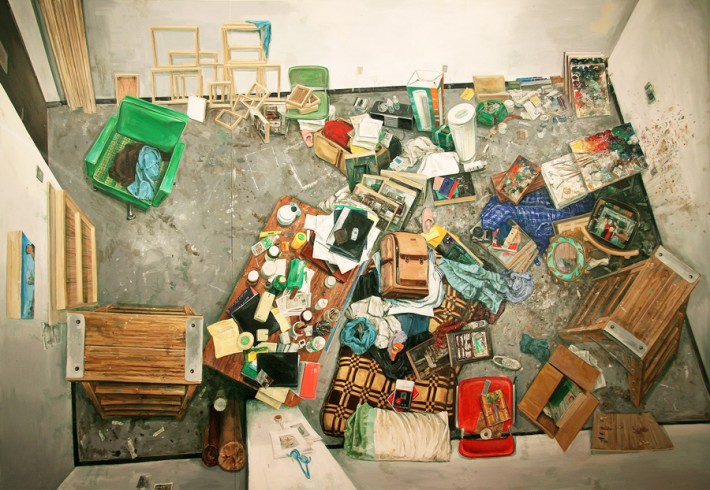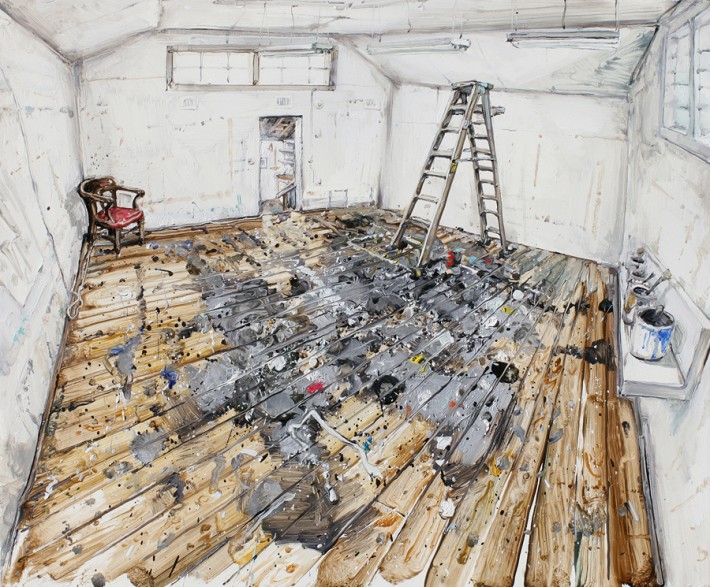By Jordan Amirkhani via dailyserving.com
In his 1971 essay “The Function of the Studio,” conceptual artist Daniel Buren defined the artist’s studio as a metadiscourse of “frames, envelopes, and limits” imposed upon the working artist in the age of advanced capitalism.[1] Claiming that this privileged space had become nothing more than an “ossified custom”—a “commercial depot” for curators and dealers to ship works out into the world (and thus detach the artwork from the conditions of production and site of creation)—Buren stated that artists could only resist the domestication of their work by preserving it within their studios forever (like Constantin Brancusi) or abandoning the four walls of the studio altogether for a life of artmaking away from institutional repression and commodification.

Amer Kobaslija. Sputnik Sweetheart of New Orleans and the End of the World, 2007; Oil on two panels; 85 x 124 ¼ in.
Buren’s provocation turns on the idealized notion of the modern atelier, described famously by Honoré de Balzac in his 1831 Romantic tale of artistic failure, The Unknown Masterpiece.[2] Setting the story in a cramped, sky-lit room cluttered with the detritus of an artist’s struggles—the idealized working environment for the solitary male genius of nineteenth-century literature and art—Balzac dramatized the central dilemma of the studio as a both a mental and physical space that encloses the corporeal and psychic “energy essential to art’s existence.”[3] Thus, Buren’s desire to re-connect the studio with social life seems to fall in line with our current era of “post-Internet artistry,” where nomadic career paths, collaborative practices, work-from-home jobs, and overnight Internet art stars are the norm, and notions of passive aesthetic contemplation and private retreat are interpreted as oppressive and old-fashioned.
A quick trip to any café exposes the ominous cloud that hangs over Buren’s call for a “post-studio” age, as Starbucks and pay-as-you-go office space evolves into the new office for artists, students, and creative professionals clicking away on their laptops. Yet the mythology of the sacred atelier persists in our contemporary culture, as Amer Kobaslija’s current series of paintings at Arthur Roger Gallery in New Orleans indicates. Taking up the weighty legacy of the artist’s studio, Kobaslija’s work explores the studio as a concept, a locus of artistic identity, a space of sociability or private retreat, an alchemical universe of transformation, as well as a psychological construct.

Pablo Picasso. Frenhofer at work on his “Unknown Masterpiece.” 1927-1931; Engraving for Ambrose Vollard’s commission of illustrations for Balzac’s Le chef-d’inconnu; 7 7/8 x 11 in.
For Kobaslija, the studio is a unique and personal world built of interchangeable stuff: floors, walls, shelves, canvases, paint, paper, chairs, tables, brushes, easels, and lighting fixtures repeat themselves across the series, their positions made mysterious by the absent bodies of the artists working (and sometimes living) inside. The invisible movements and patterned routines of the artists order the placement of these unique assemblages, turning each picture into a leftover document of the “work” of the work of art. Following the Romantic tradition (I am thinking of Gustave Courbet’s epic painting The Artist’s Studio: A Real Allegory Summing Up the Seven Year of My Artistic and Moral Life from 1854-55), Kobaslija seems to suggest that “the studio activity of the painter has never been seen as essentially private, but always somewhat performative.”[4] Yet despite the artist’s ambition to underscore the generative side of the creative process, art, for Kobaslija, always takes place in a closed room.

Amer Kobaslija. Studio with Chair and Ladder (J. Pollock, E. Hamptons), 2015; Oil on Plexiglas; 12 x 14 ¼ in.
Using the his own studio as well as the studio of his close friends, colleagues, and artistic idols such as Jackson Pollock and Balthus as subjects, Kobaslija seems to equate painting the studio with a unique form of access into the artistic process and the inner psyche—but it is an access tinged with uncomfortable voyeurism, claustrophobia, and at times emptiness. This is confirmed by the troublingly high vantage point that Kobaslija uses in each picture—an uncomfortable position that demands that the viewer take on the viewpoint of security cameras or surveillance equipment. The uneasy feeling that these painted worlds are on the cusp of breaking down or in the process of some violent, unfixable transformation adds to the ominous charge of the series. If the studio has traditionally been a place of solace from reality’s complications, this exhibition seems to respond with urgent ambiguity by asking important and unresolved questions about the place of artistic practice within today’s society, and the traditions of Western artmaking that have not (and will not) go away.
Amer Kobaslija is on view at Arthur Roger Gallery through May 30, 2015.
[1] See Daniel Buren’s essay, “The Function of the Studio” (1971) reprinted in The Studio Reader: On the Space of Artists, eds. Mary Jane Jacob and Michelle Grabner, Chicago: University of Chicago Press, 2010, pp. 156-165.
[2] See Honoré de Balzac’s Le chef-d’oeuvre inconnu, first published as “Maître Frenhofer” in L’Artiste (Paris, July 21 and August 7, 1831), revised and republished in 1837, trans. by Richard Howard as The Unknown Masterpiece, New York: New York Review of Books, 2010.
[3] Ibid., pg. 43.
[4] See Barry Schwabsky’s 2009 article “The Symbolic Studio,” in The Studio Reader, pg. 90, for a more in-depth discussion of Courbet’s studio scene.
